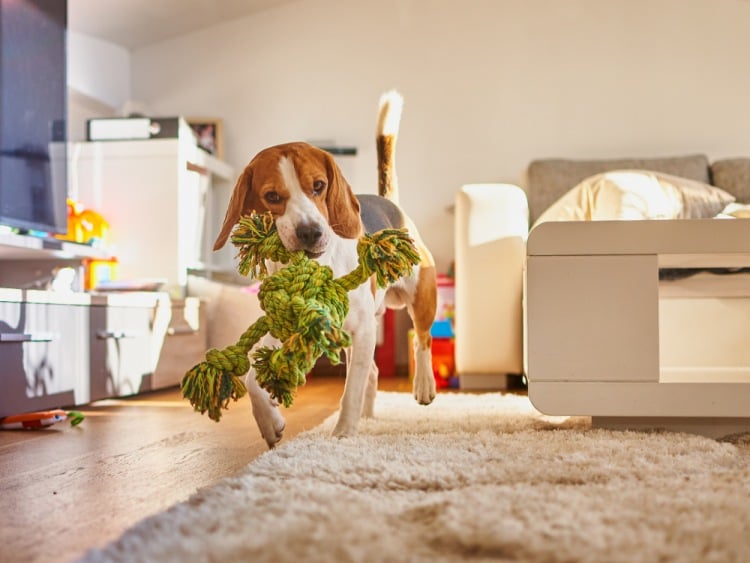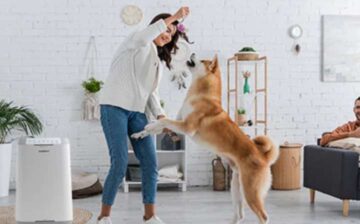Why is It A Good Idea to Pet-Proof Your Home?
 Adding a four-legged family member to your home has multiple advantages. You’ll feel safer and less lonely with your best friend to keep you company and alert you when strangers approach your door. And you’ll experience the many joys of training, playing with and cuddling your new dog, cat or other pet.
Adding a four-legged family member to your home has multiple advantages. You’ll feel safer and less lonely with your best friend to keep you company and alert you when strangers approach your door. And you’ll experience the many joys of training, playing with and cuddling your new dog, cat or other pet.
Your new pet deserves a loving and secure environment, and it’s your job to provide it. Here’s what you need to do to pet-proof your home before adoption.
1. Research the Rules
If you live in an apartment or rented home, talk to your landlord before heading to the shelter. Many pet adoption organizations, such as the Humane Society, require you to provide written documentation permitting you to take home a dog or cat. The measure is there to prevent heartbreak when living situations force an owner to surrender a pet.
Even if you own your home, you might want to check with your local authorities or association before adopting. Many residential townhomes and condominium associations enforce pet size and breed limits, such as restricting dogs over 45 pounds. It’s best to be fully aware of compliance before you fall in love with a dog that your HOA won’t want you to keep.
This doesn’t mean you can’t make a case to your landlord or HOA for allowing more flexibility. Just make sure you have a strong, empathetic argument and are willing to take full responsibility for your pet should an exception be granted.
2. Create a Safe Space
Think about the last time you moved to a new home. You felt all out of sorts for the first few days or maybe even weeks, right? Your new pet is no different – they need time to adapt to their new environment.
Dogs and cats need a space to get away from any other animals in the home and the sticky hands of toddlers. If you already have a critter or two, it’s wise to bring your new pet into a separate room, letting them get acquainted by scent first.
They also deserve comfort and a space that’s “theirs.” Please supply them with a pet bed, blanket, and toys. If you’re adopting a puppy, make crate-training positive so they associate going into the carrier with security and fun. Keep the door open when supervising the animal and toss a ball or small treats inside.
3. Find Homes for Your Houseplants
Your photos might look glorious with their long vines trailing down your corner bookcase. However, you might want to trim them back if you’re adopting a canine, or give your plant to a pal if you’re going the feline route.
Why? Certain houseplants are toxic to dogs and cats. While you can keep some species, like aloe, on a countertop away from Fido’s sniffer, it’s more challenging to deter curious kitties. Do your research or stick with artificial plants – consider it liberating yourself from the watering can.
4. Take a Puppy’s-Eye View
Hazards lurk everywhere, and safety is paramount. You should walk through your home before adoption and survey it from a pet’s perspective, just like new parents do when bringing a baby or child into a new home.
To pet-proof your home before adoption, take a puppy’s-eye or kitty’s-eye view. Get down on your hands and knees and look for hazardous objects below eye level.
If you’re adopting a feline, look upward and check your windows. Too many cats have taken an unexpected plunge when a screen came loose, and they don’t always land on their feet.
5. Get Your Kids on Board
Taking care of a pet is a glorious way to teach your kids responsibility. However, you should prepare them for what to expect.
Do a dress rehearsal the week or two before heading to the shelter. Have your kiddos write their pet feeding and cleanup time slots in their planners and practice how much time it will take to feed them and scoop any waste.
6. Invest in Child-Proof Latches
Chemicals pose as much of a hazard to pets as they do to your little ones. If your kids are already teens, it’s time to get the child-proof latches out of storage.
Are you child-free? If so, you can pick these gadgets up at nearly any department or hardware store. Keep household cleaners and garage chemicals like antifreeze safely behind lock and key.
7. Clear Your Yard of Hazards
You might not think of your backyard as dangerous. However, that stray nail you dropped while building your deck could puncture your puppy’s foot.
Clear your yard of hazards – including any poisonous plants that Fido might be tempted to eat. If you plan on leaving your pet in your yard unsupervised, inspect the fencing for any egress points where your puppy could escape.
It’s better to leave felines indoors. While cats may only live a few short years in the wild, they can get well into the double digits when not threatened by things like coyotes and speeding cars.
Pet-Proof Your Home Before Adoption
Bringing home a new furry family member is a joy. It’s also a big responsibility. It’s your job to ensure you’re bringing and relocating your pet into a secure environment.
Fortunately, it doesn’t take too much work to prepare for your new fluffy bundle of joy. Follow the tips above to pet-proof your home and enjoy a successful, life-affirming pet adoption.
We hope you found this blog post How to Pet-Proof Your Home Before a Pet Adoption useful. Be sure to check out our post Make Your Moving Stressless For Your Pets! for more great tips!

Have Experience in the Moving Industry? Want an Additional Income Stream? Work With All Around Moving!
All Around Moving’s Work With Us program helps you profit. Earn extra income while applying your knowledge in the moving industry. Click here to learn more.



